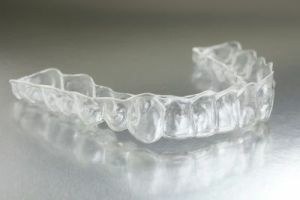 Many people are faced with the problem of gnashing their teeth in a dream, but do not identify this phenomenon as a disease.
Many people are faced with the problem of gnashing their teeth in a dream, but do not identify this phenomenon as a disease.
The official medicine has another version. Disease, characterized by friction of teeth and jaw clenching, is called bruxism. This is not only a dental problem, but also a diagnosis of sleep disorders.
Contents of
- What is kappa?
- What you need to know about bruxism
- Functionality of the dental lining
- What solutions are offered?
- Manufacturing and technical details
- Care and storage features
- Price
What is a kappa?
The edentulous kappa is a removable orthodontic device. It is made of flexible plastic and has a special shape. In most cases, the design is transparent and flexible enough so that the patient does not feel any discomfort when wearing.
The material from which the mouthguards are made, hypoallergenic, consists of modern biopolymers. The device withstands a sufficiently strong load, for a long time without yielding to deformation. The capa ceases to be felt about an hour after wearing, it is easy to clean, if necessary, it can be removed without difficulty.
Modern orthodontics provides kappas of any color. You can make it individually, based on the color of the customer's teeth. In addition, on them, if desired, even patterns or inscriptions are applied. There are two-jaw designs( simultaneously on two jaws) and single-jawed.
What you need to know about bruxism
Bruxism is a gnashing of teeth and reflex jaw constriction, most often manifested during sleep. Previously it was believed that such involuntary actions do not affect health and do not pose a serious threat. Later it was proved that this is rather a bad habit.
During sleep, when consciousness rests, the subconscious works. It is it that activates the mechanism of chewing and compression of teeth.
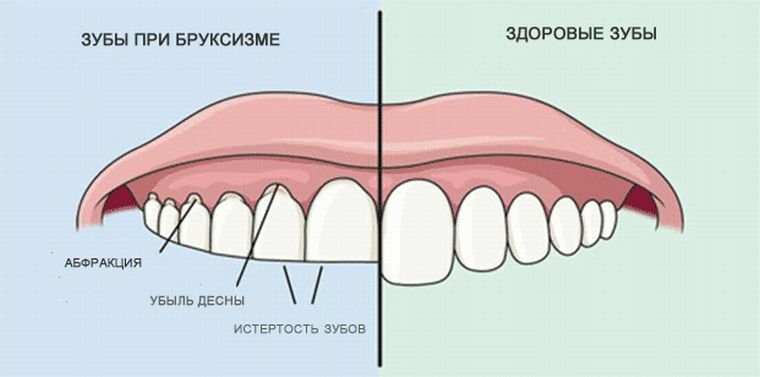
The exact causes of the disease are not yet known. However, specialists are inclined to the fact that there are provoking factors:
- stimulant reception;
- alcohol abuse;
- smoking;
- stress;
- mental disorders;
- problems of the gastrointestinal tract.
Functionality of the dental lining
Bruxism at night leads to negative consequences, becausea person at this time can not control the movements of the jaw. The pressure on teeth with a pathological gnash is ten times greater than with normal chewing.
There are two options for dealing with the problem: the introduction of special injections of Botox into the muscles of the jaw and wearing a nightcap. The latter option gives a one hundred percent guarantee of dental safety. This is a special design that does not need to be confused with kappas for leveling or whitening your teeth.
Functions of the night occlusal mouthguard: 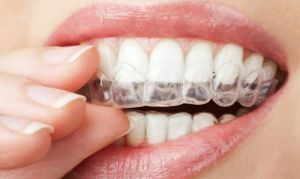
- decrease in pressure and tension on the maxillofacial device;
- prevention of tooth dislocation;
- protection of tooth enamel from chips, cracks, abrasion;
- prevention of malocclusion;
- sleep normalization;
- guarantee the safety of orthodontic structures( if any).
Bruxism can cause headaches, discomfort in the neck and back, insomnia, the kappa constantly reacts to the compression of the dentition, which eliminates the imbalance of muscles, improves their coordination, relaxes the jaw. In addition, they are used even to prevent symptoms of nocturnal sleep apnea.
What solutions are offered?
Differences between the one tray and the other can be determined by the way they are manufactured or for the intended purpose.
For the intended purpose of the cap, which are used in bruxism, are divided into three types:
- Daytime .Such designs are used for complicated dental scrapes. When a person does not sleep, he can control the process of squeezing and unclenching the jaws, but in some cases this is impossible. For this, a kappa is installed, which must be worn throughout the day. The device is not visible when talking, allows you to eat food without discomfort, does not violate speech.
- Nightly .These structures are used only during sleep. You can not wear them during the day - this can provoke serious problems of the maxillofacial apparatus. The patient himself puts them on before going to sleep and must be removed after waking up. Sleeping eyes, which are used in bruxism, are usually visible, but this does not create problems, becausethe person in a dream does not contact anyone.
- Resonant .Such devices are used for complicated disease and in emergency cases. They not only protect the jaw and teeth, but also have medicinal properties.
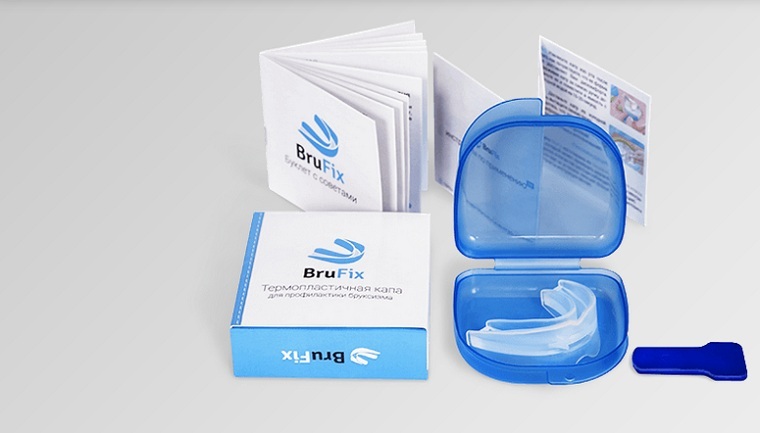
Brufix kappa for sleep
By the way of construction construction there are:
- Standard .Produced according to a certain pattern and ready for use. May cause discomfort.
- Thermoplastic .Such kappas are made of special material. They need to be immersed in hot water before use. This is done to soften the material, so that, wearing on the teeth, the design takes their shape and stiffens in this position.
- Individual a tooth-dropping kappa is made on a patient's impression. It is most comfortable to wear and does not cause unpleasant sensations.
Manufacturing and technical aspects of
In order to be effective and comfortable to wear, it is necessary to observe the rules for the manufacture of the device. The main goal in this case - tight fit to the teeth and the integrity of the body. Without jags and bulging areas.
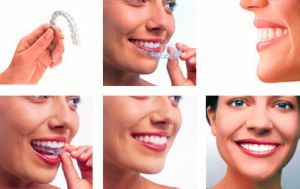 As already mentioned, you can buy a ready-made design, but its use may not be comfortable and inconclusive. Therefore, it is better to go to the dental office to make an individual kappa. This design is performed taking into account the individual characteristics of the jaw structure and the teeth of each patient.
As already mentioned, you can buy a ready-made design, but its use may not be comfortable and inconclusive. Therefore, it is better to go to the dental office to make an individual kappa. This design is performed taking into account the individual characteristics of the jaw structure and the teeth of each patient.
The material is plastic, which polymerizes under pressure. To make the design of the village perfect, it is necessary to shoot casts from one or two jaws, depending on the specific problem.
The main technical moments of making the correct kappa:
- Removing the molds .With the help of an impression spoon, the dentist treats the surface of the teeth and jaws with a thick, elastic mass. After compression of teeth an individual impression is formed.
- Gypsum model .In the dental laboratory, a plaster mixture of water and gypsum powder is applied to the finished impression. It freezes, and after that a molding mass is extracted from the solidified model.
- Directly manufacturing .The material from which the kappa will be made can be in the form of elastic plates or a homogeneous mass. It is placed in a molding machine in which a kappa is produced under pressure and at a temperature of about +140 degrees. After that, it is laminated, covering with several layers of a special agent, so that it is smooth and strong. The result is a design with soft inner walls and a strong outer surface.
The ready-made kappa is passed on to the attending physician, he invites the patient and tries on it. If everything is done correctly - the person himself can remove and install the device without effort and discomfort. If there are some inaccuracies - the device is sent for revision.
Features of care and storage
The maintenance of a design in cleanliness - here the basic care for a kappa. It is washed with running water( sometimes with a soap solution), then it is cleaned with a toothbrush and paste. Rinses the device and you can use it again.
It is recommended to store the cap in a solid container with holes for ventilation. To ensure a long life, it is necessary to protect it from the effects of high temperatures( this can cause deformation), regularly inspect for integrity. When visiting a dentist, a kappa is also recommended to show the doctor.
Average service life of the night cap from six months to one year. If we are dealing with complicated bruxism, the design will have to be changed more often.
Price of the issue
The price of the toothbrush can be significantly different, so, ready-made brushes, which can be bought at the pharmacy and do not require 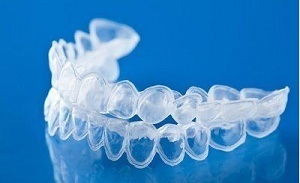 any additional installation costs, will cost around 2000-2500 rubles.
any additional installation costs, will cost around 2000-2500 rubles.
Constructions made according to individual parameters are more expensive. They include the cost of the material, the cost of the cast and clay model, the work of the dental laboratory and molding machine, as well as the work of the specialists of these departments and, of course, a series of visits to the dentist. Such a kappa will cost 5000-10000 rubles.
Capa is the most effective remedy for bruxism. In advance, taking care of the state of the temporomandibular joint and teeth, the patient will receive not only protection of health, improvement of well-being, but will also retain the aesthetics of his appearance.
